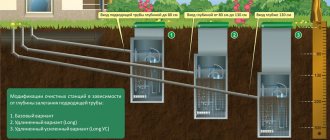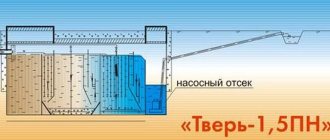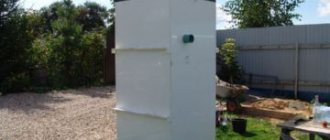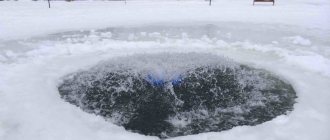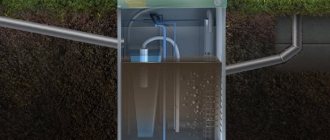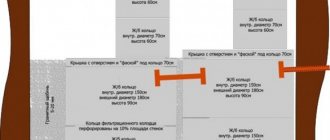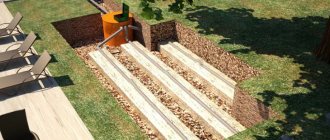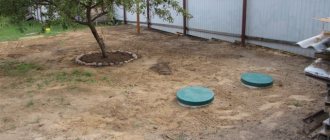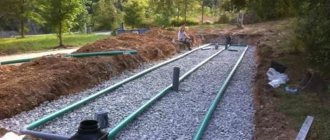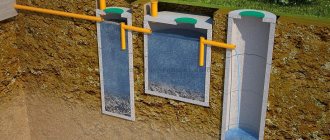Tver is an unpretentious biological treatment plant. The receiving chamber in it serves to sediment suspensions, and the overflows between the chambers are gravity-fed, as in septic tanks. There are no blockages. However, the autonomous sewer system must be maintained. There are some nuances here.
Service includes:
- Pumping sludge into the receiving chamber
- Sludge pumping
- Washing the brush load and washing away deposits from the walls
- Cleaning the compressor filter
- Air supply setting
- Replacing the download
We'll tell you about all the stages. Finally, we will give advice to those who find cleaning a septic tank difficult.
Boot replacement
Expanded clay in the first aeration tank gradually silts up. Once every 2-3 years it is removed and a new one is added. We advise you not to delay it, as compacted expanded clay will be difficult to remove. A sludge pump is also called in to pump out expanded clay.
Expanded clay for filling into the first aeration tank
Dolomite crushed stone in the second aeration tank dissolves over time. It is added as it decreases. It is enough to fill one bag at a time.
Limestone (dolomite) crushed stone for filling into the second aeration tank (aerobic bioreactor)
Septic tank installation Tver
First of all, you need to find a place where you will install the treatment station. If you plan to use a sewage disposal truck to pump out the first septic tank, you need to take into account the possibility of its access. For the rest, it is necessary to take into account the requirements of regulatory documents:
- from the road, house and buildings at least 5 m;
- from garden trees - at least 3 m;
- from the reservoir - at least 10 m;
- from a well or borehole (your own or a neighbor’s) - at least 20 m.
The task is not easy. Having found a place for installation, you need to decide on the groundwater level and type of soil. You need to know the level when the water is high (in the spring after the snow melts or in the fall during heavy rains) and also how deep the water is during the rest of the year. The method of discharging purified water depends on this. After the Tver septic tank, it can be immediately dumped onto the ground without additional purification, but if you sometimes have water standing on the site, there is no point in adding it. For such cases, a storage well is installed into which wastewater is drained in such situations. Then they are pumped out using a drainage pump.
Choosing a place is not easy
The type of soil influences the choice of installation method. If the soil drains water normally (sand, sand, loam with a lot of sand), the Tver septic tank is filled with sand. If clay predominates in the soil, and the groundwater level is high, a concrete slab is laid/poured at the bottom, to which the septic tank body is tied. In this case, the gap between the wall of the pit and the septic tank is filled with a cement-sand mixture (1 to 5).
To insulate or not
When installing an autonomous sewer system in Tver, the question often arises: should it be insulated or not? If it will be used all year round, if you do not leave the house in winter for more than a couple of days, you don’t have to insulate it. The drains are warm, reactions occur with the release of heat, and the compressor pumps warm air from the house. In this mode, the treatment plant will not freeze. If you go on vacation in the winter, or are installing a sewer system at your dacha, which is visited occasionally in winter, then it is better to insulate the upper half of the body.
It is better to insulate with extruded polystyrene foam
To insulate a septic tank, it is better to use extruded polystyrene foam rather than polystyrene foam. It is, of course, more expensive, but with the same thickness it is much “warmer”, does not absorb water, does not discolor and is not eaten by rodents and insects, fungi and bacteria do not multiply on it. For the Middle Zone, it is enough to lay 5 cm of insulation, another thing is that it is better to make two layers - 2+3 cm, lay the slabs so that the seams of the first row overlap the second. It is fashionable to attach it with liquid nails, then it will still close and be pressed down by the soil.
Work order
Installation methods vary, but they have general rules. Details need to be thought through/found out as questions arise, and preferably before installation. Here's how to install a septic tank Tver:
- We dig a pit 25-30 cm larger than the dimensions of the body. The depth depends on the type of installation: on soils that drain water well, a sand cushion 10 cm thick is needed; on clay soils, a reinforced concrete slab is installed or poured. Depending on the thickness of the slab, adjustments are made to the depth of the pit.
- Towards the pit, trenches are dug from the house to the inlet pipe, observing the slope of the sewer (when using a 100 mm pipe - 2 mm per meter). It also digs down to the waste disposal area.
- A sewer pipe (preferably plastic for outdoor use, red in color) and an air duct from the compressor (at a depth of at least 70 cm) are laid immediately from the house. To prevent the septic tank from freezing in winter, the pipeline is insulated.
Pipe inlet and compressor inlet - The bottom of the pit is leveled and compacted.
- The sand is placed on a leveled and compacted bottom. The first layer is 5 cm, leveled, spilled with water, compacted to a high density. The second layer is laid in the same way, only it still needs to be level.
- The surface of the slab must be level. It should have fitting outlets to which metal strips can be welded to hold the septic tank. If there are no outlets, you can install anchors and attach tie rods to them.
An example of anchoring a septic tank with anchors - Before fixing the septic tank body, you need to check whether it is level. Permissible deviation - between the front and rear ends of the blocks - no more than 10 mm, vertical deviation - no more than 5 mm.
- Connect pipelines, compressor hose,
- The exposed building is covered with: sand, if the ground level is low and the soil drains water well;
- sand with cement (5:1) if the ground level is high and/or the soil is clayey (clay and loam).
Backfilling with sand layer by layer with compaction
As you can see, the installation is not the most difficult, but it requires care. Care must be taken to lower the housing without damaging it. Sand or mixture must be compacted no less carefully.
You have to lower it carefully
Installation option at high groundwater level
For such a case, you can bury half of the body and fill up the other half, making an artificial hill. Slopes can be strengthened with a special Geodor lattice or something similar. Plant grass with strong roots in the ground. But this option is not always possible - the pipes from the house must be laid with a slope.
What to do before launch
When transporting a septic tank, some parts may become dislodged. You need to check:
- Are the loads in place - expanded clay and lime;
- pipelines (pop out of clips);
- brush nozzle;
- chlorine cartridge.
When working, you must be careful not to damage the aerators that are located under the backfill. Having installed everything in place, seal the neck of the septic tank with rubber gaskets, and you can coat it with bitumen mastic. Then install sludge pumps; if there is a pump, place its plug in the neck.
It is necessary to check whether everything is on site after transportation.
Electricity must be supplied through a cabinet mounted on special racks and grounded. The bottom of the cabinet should be 70 cm above ground level. Connect the input from the switchboard to the terminal blocks, and connect the control cable that goes to the control panel on the arc side. Install the float switch and route its cable to the appropriate terminals in the cabinet.
Check functionality:
- plug the pumps into the socket in the cabinet for a few seconds (if pumps are included);
- by raising the float switch, simulate filling the septic tank and see if the pumps work.
Next, you can fill the system with water and check its performance. That's all, the Tver septic tank is installed.
conclusions
On the one hand, the septic tank is easy to maintain. Pumping needs to be done only once a year. But the details are a little more complicated:
- Before pumping, open the taps to pump the sediment into the receiving chamber.
- They call a vacuum cleaner to pump it out. This requires expenses (about 1000 rubles per 1 cubic meter) and time. It is necessary to check the operation and immediately add water after pumping.
- They wash the brushes and walls from the inside with a Karcher, especially if there has been no maintenance for a long time.
- Remove the air filter from the compressor and clean it of dust (it is best to wash it with water).
- Every few years they change the load - they remove the silted expanded clay and pour in new ones, and add dolomite crushed stone.
- Periodically check how the aeration is set and, if necessary, adjust it.
Does maintenance seem like a hassle to you? Call a Zagorod service engineer. Our employee will come to you, wash the septic tank, clean the filter, change the load if necessary and adjust the aeration. We have only experienced employees on our staff. You will save time and be confident that the service was done correctly.
Recommended products
The lineup
Tver septic tanks are available in different volumes for different amounts of waste. Each model has modifications that have a different letter designation:
- P - plastic case (without the letter, metal case).
- N - there is a pumping compartment for forced pumping of purified water (a necessary option for high groundwater levels and a scheme with an intermediate well). If there are two letters H, then there are two pumps. The NPN marking indicates that there is a special compartment for installing the pump (otherwise it is suspended).
- M - increased insertion depth. Standardly, the inlet is located at a depth of 30 cm; in this modification it can be lowered to a level of 60 cm. In this modification, the position of the walls also changes; the height of the manhole necks does not change.
The sizes, volume and price of some models of septic tanks in Tver are summarized in a table.
| Name/modifications | Productivity per day | Number of users | Dimensions (L*W*H) | Price | Salvo release |
| 0.35 P/0.35 PN | 350 l/day | up to 2 | 1.4*1.1*1.65 m | 938$/980$ | 100 l |
| 0.5 P | 500 l/day | until 3 | 1.65*1.1*1.67 m | 995$ | 150 l |
| 0.5 PN | 500 l/day | until 3 | 2*1.1*1.67 m | 1110$ | 150 l |
| 0.5 RM | 500 l/day | until 3 | 1.65*1.1*1.97 m | 1165$ | 150 l |
| 0.5 PNM | 500 l/day | until 3 | 2*1.1*1.97 m | 1285$ | 150 l |
| 0.75 P | 750 l/day | until 3 | 2.25*.086*1.67 m | 1150$ | 250 l |
| 0.75 PNM | 750 l/day | until 3 | 2.65*.086*1.97 m | 1550$ | 250 l |
| 0.75 NLNM | 750 l/day | until 3 | 3.05*.086*1.97 m | 1685$ | 250 l |
| 0.85 P | 850 l/day | up to 5 | 2.1*1.1*1.67 m | 1250$ | 280 l |
| 0.85 NP | 850 l/day | up to 5 | 2.1*1.1*1.67 m | 1385$ | 280 l |
| 0.85 NPN | 850 l/day | up to 5 | 2.5*1.1*1.67 m | 1540$ | 280 l |
| 1 Mon | 1000 l/day | from 3 to 5 | 3*1.1*1.67 m | 1780$ | 350 l |
| 1 PNM | 1000 l/day | from 3 to 5 | 3*1.1*1.97 m | 1805$ | 350 l |
| 1 NPNM | 1000 l/day | from 3 to 5 | 3.35*1.1*1.97 m | 1980$ | 350 l |
| 1.2 P | 1200 l/day | up to 5 | 2.88*1.1*1.67 m | 1555$ | 400 l |
| 1.2 RM | 1200 l/day | up to 5 | 2.8*1.1*1.97 m | 1790$ | 400 l |
| 1.2 NPM | 1200 l/day | up to 5 | 3.6*1.1*1.67 m | 1845$ | 400 l |
| 1.5 P | 1500 l/day | from 5 to 7 | 3.5*1.1*1.67 m | 1780$ | 500 l |
| 1.5 NPR | 1500 l/day | from 5 to 7 | 4.1*1.1*1.67 m | 2120$ | 500 l |
| 2 Mon | 2000 l/day | from 7 to 10 | 4.5*1.3*1.67 m | 2410$ | 650 l |
| 2 PNM | 2000 l/day | up to 12 | 4.5*1.3*1.67 m | 2570$ | 650 l |
| 3 P | 3000 l/day | up to 15 | 4*1.6*1.67 m | 2535$ | 800 l |
| 3 NPNM | 3000 l/day | up to 15 | 5*1.6*1.97 m | 3030$ | 800 l |
| 4 P | 4000 l/day | up to 20 | 4*1.3*1.67 m | 4190$ | 1200 l |
| 6 P | 6000 l/day | from 22 to 30 | 4*1.6*1.67 m | 5000$ | 2000 l |
Manufacturer
The manufacturer of the Tver septic treatment plant is the Engineering Equipment trading house. The company has been on the market for over 20 years and produces highly specialized equipment: autonomous sewers and treatment plants.
You can learn more about the products of the trading house by visiting the official website of the manufacturer. In addition, on the manufacturer’s official website you can find additional components for installing the Tver septic tank treatment plant, as well as see photos and videos of the equipment.
4. Compressor maintenance, cleaning the air filter
To do this, unscrew and remove the compressor cover, remove the filter and wash it in warm water.
After drying, put the filter in place and screw on the lid. Procedure for cleaning the filter
Reviews:
October 24, 2019
Pumping and maintenance of septic tank Tver
The septic tank was installed in 2010, in 2021 we cleaned it ourselves and at the same time bought new components.
In October 2021, we decided to pump it out, wash it and service it professionally with the help of the company. I started calling different offices and they all said that I needed to change the brushes and chalk and pebbles. Why, because I already changed them 3 years ago. I really liked the communication at the Super-septic Company, and also the fact that they did not offer me replacement components - it was honest, and therefore surprising. They served everything wonderfully and efficiently. Irina, Kashirsky district, village. Korostyleva
May 14, 2019
Septic tank Tver maintenance.
A Tver septic tank was installed in 2010 for a large house.
A few years later, the same one installed a small Tver in my bathhouse. It’s 35 meters from the road to the bathhouse. A special barrel with a long, long sleeve arrives - this is a rarity. Every time they recognized me on the phone and showed respect. I have already ordered maintenance from them several times. They come when it’s convenient for me – on weekends. Always with your own sewer truck. They work for about an hour and a half. Everything is washed, including brushes. I order service once every two years. I chose a septic tank, at one time, for a very long time and thoroughly. It was important for me that it didn’t stink and worked without electricity, during blackouts, etc. I live in Vladimir region. It’s good that the company has continued to operate all these 10 years. I really... Sergey, Vladimir region, Kirzhachsky district, Krasny Ogorok village
May 14, 2019
Septic tank Tver. Service.
Installed a super septic tank in Tver in 2021. For 5 people - 0.75 PN.
The pump threw out, at first, clean water. This year, the smell began to appear periodically. I took off the covers and there was a lot of dirty sludge floating in the pump chamber. I started calling different companies. Nobody could explain the reason. Many said this was the norm. I received excellent advice over the phone. Within 20 minutes the cause was identified. It turned out that earlier, during the installation of the container, the outlet hose was inserted into the wrong place, and primer got into it. There was an overflow. I invited their specialist and a barrel for pumping. Indeed, an engineer arrived in his car. Explained everything, showed it, set it up. The smell went away by evening. Thank you very much... Roman. , Moscow region, Leninsky district. With. Bulatnikovo
Model: Septic tank Tver-0.75PN
All reviews
Work order
For full maintenance of the Tver septic tank, you will need a fecal pump or a sewer truck, steel rods for loading, a sink or a water hose for cleaning the walls, and a significant amount of water. The work order is as follows:
- All septic tank lids open to provide full access to the internal contents.
- The middle tap closes smoothly, the two outer ones gradually open for 15-20 minutes. During this time, the sludge located in subsequent compartments will move into the first chamber. After this, the taps are closed.
- The excess sludge that has passed into the first chamber, along with all its contents, is pumped out. To do this, you can use either a fecal pump or special transport, which will handle it faster.
- From the bioreactor, brush filters are washed under high water pressure, if necessary. To prevent breakdowns, it is necessary to replace the metal parts supporting the filters.
- Using a high-pressure washer or a water hose, carefully clean the walls of the container if they have been subjected to excess deposits. The excess water accumulated in the chambers of the equipment during this process is removed using a pump.
- If necessary, limestone and expanded clay loading is poured into the air tank if it is finished.
- The cover is removed from the compressor (you need to unscrew the bolt), the filter is removed, then washed under warm water, dried thoroughly and returned to its original position inside the compressor.
After completing all the work, you need to check the correct position of the three taps (the two outer ones are closed and the middle one is open) and replace all the covers of the local treatment plant, ensuring its tightness.
You can carry out maintenance activities for the Tver septic tank either independently or by calling the company’s specialists. As a rule, the cost of the service falls within an acceptable framework, and if you do not want to understand the structure of the equipment and spend time cleaning it, you can entrust this to specialists who work 365 days a year throughout the Moscow region, as well as the nearest regions: Tverskaya, Vladimirskaya , Tula, etc.
Characteristics and types
The flexible hose for connecting plumbing is a hose of different lengths made of non-toxic synthetic rubber. Thanks to the elasticity and softness of the material, it easily takes the desired position and allows installation in hard-to-reach places. To protect the flexible hose, there is an upper reinforcing layer in the form of a braid, which is made from the following materials:
- Aluminum. Such models can withstand no more than +80 °C and retain functionality for 3 years. At high humidity, aluminum braiding is prone to rust.
- Of stainless steel. Thanks to this reinforcing layer, the service life of the flexible water line is at least 10 years, and the maximum temperature of the transported medium is +95 °C.
- Nylon. This braid is used for the manufacture of reinforced models that can withstand temperatures up to +110 °C and are designed for intensive use for 15 years.
The fasteners used are nut-nut and nut-fitting pairs, which are made of brass or stainless steel. Devices with different permissible temperatures differ in the color of the braid. Blue ones are used to connect to a pipeline with cold water, and red ones for hot water.
When choosing a water line, you need to pay attention to its elasticity, reliability of fasteners and purpose. It is also mandatory to have a certificate that prevents the rubber from releasing toxic components during operation.
Model selection principle
This type of treatment facility is selected based on its daily flow rate and the magnitude of the salvo discharge. You calculate your daily consumption based on the number of residents and all the procedures they undergo every day.
For example. Family of 3, there is a washing machine, dishwasher, shower/bathtub, toilet, kitchen sink. We count how many times a cistern can be flushed on average per day, multiply by its capacity, and find how much water is flushed when the toilet is installed. Next, we calculate how much water is spent on laundry, washing dishes, washing, how often family members take a shower, bath, etc. We sum up all the data and get the number of drains per day.
You need to choose the size for the salvo discharge or the daily amount of waste
Now we calculate the magnitude of the salvo discharge. This is the volume that an individual sewerage installation can process within 2 hours. Most often, at a minimum, this is the volume of two bathrooms or the amount of water that a family spends during an evening/morning shower + toilet flushes + water for washing + cooking + washing dishes. This is if all these processes occur simultaneously.
Knowing these two numbers, you select a model. In the selected model, both numbers should not be less. More - easily, less - the installation is unlikely to cope. As a rule, the main criterion is salvo discharge. Since if the installation cannot cope with such an amount of water, untreated water will leave the septic tank. As professionals say, there will be a removal of silt, and accordingly, a smell and accompanying “charms” will appear.
Types of sewage systems for summer cottages are described here.
User manual
To extend the service life of the Tver septic tank and optimize its operation, it is recommended that you familiarize yourself with the basic requirements for operating a wastewater treatment system:
- The following types of substances are not allowed to be discharged into the sewer system: concentrated
alkalis and acids, toxic substances, alcohol-containing substances. They disrupt the activity of anaerobic bacteria, and incomplete purification of discharged water occurs.
- If the septic tank operates disconnected from the electrical power supply, it is recommended to reduce the volume of water supplied by approximately half. For example, for the “Tver - 0.35P” model, the maximum productivity of which is 250 liters, it is recommended to reduce this figure to 125 liters.
- Do not use the sewer system to dispose of naturally insoluble waste (polyethylene, plastics, rubber, etc.).
Expert advice
Krotov Nikolay Vladimirovich, engineer for the development of autonomous treatment facilities.
The Tver septic tank today belongs to the group of technological wastewater treatment devices and is able to fully satisfy the needs of a person who wants to have an autonomous sewer system. At the same time, the cost category of this product on the market is slightly higher than that of many analogues.
In this regard, when choosing, you need to be guided by the actual required productivity (volume of water and number of people) - you should not purchase a septic tank with obviously inflated performance. This will increase the purchase price, as well as turnkey installation and subsequent maintenance costs.
Our works
October 15, 2019
Maintenance of septic tank Tver in Mytishchi
Moscow region Urban district Mytishchi village.
Malaya Ivanovskaya October 4, 2019
Maintenance and cleaning of septic tank Tver
Moscow region Odintsovo district village.
Podlipki July 17, 2019
Maintenance of septic tank Tver 2P
Moscow region Mytishchi urban district, village.
Zhostovo September 22, 2018
Installation of a septic tank Tver 0.35PN
Tver 0.35PN, Solnechnogorsk district, Timonovo
September 18, 2018
Repair of external septic tank hood
External hood repair in Pushkinsky district
Device
Tver septic tanks are a monolithic polypropylene container with one or more (depending on modification) necks in the upper part and inlet and outlet pipes in the end walls.
The bottom of the installation has a rounded shape, eliminating the possibility of the tank floating up during a strong rise in groundwater. The shape of the container is clearly visible in the photo.
Photo: general appearance of the original shape of the Tver septic tank
The internal part of the tank is divided by partitions into 6 compartments, each of which is used for a specific technological process of wastewater treatment. In addition to the partitions, the cavity of the container contains a network of pipelines to ensure aeration, as well as special fillers (brush, expanded clay, limestone loading).
Photo: internal loading of a working septic tank
A video will help you see clearly what a Tver septic tank is.
How does this sewer system work?
The process is organized in a flow mode - the liquid goes through all stages of purification by gravity. Therefore, a power outage does not become a disaster - the compartments do not overflow and the station continues to function and perform high-quality cleaning for at least a day.
Such design features make it possible to effectively use the Tver septic tank both for a dacha with seasonal or periodic use, and for a house with permanent residence.
In the tank, the wastewater undergoes four stages of fine biological treatment.
Primary settling and anaerobic fermentation
Through sewer pipes, sewage enters the primary settling tank, where sedimentation, mechanical separation occurs, and treatment with microorganisms begins. Hydrobionts enter here along with wastewater from the anaerobic bioreactor, as well as with activated sludge from the secondary and tertiary settling tanks.
Under the influence of bacteria, large heavy structures are broken down, and wastewater is separated according to specific gravity. Heavy, poorly soluble particles settle to the bottom, light fatty fractions rise to the surface.
Sludge and fat film are also gradually processed, but this takes longer. As a result, only solid sediment remains, which must be pumped out.
The next section is an anaerobic bioreactor, where colonies of anaerobic bacteria are concentrated. Relatively clean water from the middle layer of the septic chamber enters here.
Due to the content of a large amount of organic matter, fermentation and sedimentation of sludge on the fibers occurs in the loading space. Hydrobionts break down difficult-to-oxidize and complex organic compounds into simple ones.
A similar separation process occurs in the primary settling tank of the treatment plant. Already clarified liquid enters the next section
Oxidation and aerobic decomposition of organic matter
Water with simple suspensions enters the next section - the aeration tank, where constant aeration is carried out. In an oxygenated and nutritious environment, aerobic bacteria begin to work. They use simple organic matter as food to maintain their metabolism. As a result, the water is saturated with active suspensions.
A layer of gravel is poured onto the bottom of the aeration tank. The remains of bacterial activity (metabolites), as well as some organic matter, settle on it. Due to this, an environment for the reproduction and growth of anaerobes is formed and activated sludge is formed.
Together with air bubbles, it rises again, and the bacteria continue to work throughout the entire volume of the chamber. Next, this “agitated” liquid enters the secondary settling tank. The process subsides, the particles settle.
The secondary settling tank and the aeration tank are connected sections, so the activated sludge, settling, returns to the aeration tank chamber. The clarified water flows further through the upper overflows into the aerobic bioreactor.
In the bioreactor chamber, conditions have been created for the growth and reproduction of huge colonies of aerobes. Water saturated with oxygen and organic residues passes through a brush bioload, in which the same processes occur as in the aeration tank. Only much more active.
The lion's share of activated sludge settles on the fibers of the ruffs and is processed by bacteria until complete decomposition.
Activated sludge is flakes of gray, dark brown and dark gray color - zooglea. These are accumulations of living microorganisms and solid media, covered with a common mucous membrane
Neutralization of toxic compounds
In addition to organic matter and insoluble heavy suspended matter, household wastewater contains toxic substances. Detergents and cleaning products used for bathing, laundry, dishwashing or cleaning contain phosphates and nitrogen compounds.
They dissolve in water and do not settle or decompose by bacteria. It is prohibited to drain water containing toxic compounds into the ground - this threatens environmental damage.
To neutralize them, a layer of limestone is placed in the bottom area of the bioreactor section. It reacts with phosphates and nitrogen compounds and forms insoluble salts, which precipitate.
Final settling and disinfection
The last stage of purification is the settling of water in a tertiary settling tank. The remaining metabolites and neutral salts formed by the combination of phosphates and limestone settle here. As a result of passing through all chambers, the wastewater is completely cleared of contaminants - the degree of purification is 98%.
The process of purifying household waste consists of four stages of purification: mechanical separation, fermentation and breakdown of complex substances into simple ones, oxidation and aerobic breakdown of organic matter, final settling and disinfection (+)
In a tertiary settling tank, practically pure water is disinfected. To do this, chlorine-containing tablets are placed in a special float.
Purified water can be discharged onto the terrain and into a natural body of water. However, resource saving trends are increasingly spreading not only in Europe, but also here.
Therefore, more and more economical owners are using treated wastewater again - for irrigation, for technical or economic needs.
Image gallery
Photo from
Absorption sewer well
Drainage sewer pipe system
Filtration field for water recycling
Discharge of purified water into the drainage ditch
Disposal of excess activated sludge
With a sufficient amount of nutrients, the increase in the biomass of aerobic bacteria occurs very intensively. In this case, a lot of activated sludge is formed. To dispose of its excess, airlifts are installed in the secondary and tertiary settling tanks.
An airlift is a jet pump that lifts liquid using compressed air. The design is very simple - it consists of two tubes and a compressor. One of the pipes carries air under pressure. It is connected to the bottom of the second pipe, lowered into the water.
An air-water emulsion is formed - a liquid filled with air bubbles. Its specific gravity is less than the specific gravity of the water surrounding the pipe.
Due to this, it rises up the pipe - denser water simply pushes out the lighter air-water mixture. The suspended matter contained in the water also becomes part of the emulsion and rises successfully.
Two airlifts installed in the Tver septic tank, together with the liquid, lift excess activated sludge from the aeration tank and tertiary settling tank sections. The sludge line pumps the mixture into the septic tank. The cycle is completed.
The more air bubbles in the mixture, the lighter it is. Accordingly, such a mixture rises better and pumping occurs more efficiently
Price
Average retail prices are indicated based on consideration of the proposed cost for this equipment by different companies. You can buy a septic tank both on the manufacturer’s website and from a number of third-party partners and distributors.
| Name | Frame | Number of users | Cost, thousand rubles. |
| Tver - 0.75P | polypropylene | 3 | 64 |
| 0.75PN | 73 | ||
| 0.75RM | 74 | ||
| 0.75PNM | 83 | ||
| Tver - 1P | 3 — 5 | 82 | |
| 1PN | 92 | ||
| 1RM | 92 | ||
| 1PNM | 102 | ||
| Tver - 1.5P | 5 — 7 | 104 | |
| 1.5PN | 114 | ||
| 1.5RM | 114 | ||
| 1.5PNM | 124 | ||
| Tver - 2P | 7 — 10 | 124 | |
| 2PN | 134 | ||
| 2RM | 134 | ||
| 2PNM | 144 | ||
| Tver - 3P | 10 — 15 | 143 | |
| 3PN | 154 | ||
| 3RM | 154 | ||
| 3PNM | 164 | ||
| Tver - 4.5 | steel | 15 — 22 | 274 |
| 4.5N | 284 | ||
| Tver - 6P | polypropylene | 22 — 30 | 285 |
| 6 | steel | 310 | |
| 6H | 319 | ||
| Tver - 10 | 30 — 50 | 430 | |
| 10N | 440 | ||
| Tver - 12 | 35 — 60 | 499 | |
| Tver - 16 | 50 — 80 | 620 | |
| Tver - 20 | 60 — 100 | 699 | |
| Tver - 25 | 80 — 125 | 893 | |
| Tver - 30 | 100 — 150 | 950 | |
| Tver - 40 | 125 — 200 | 1200 | |
| Tver - 50 | 150 — 250 | 1424 | |
| Tver - 60 | 200 — 300 | 1853 | |
| Tver - 80 | 250 — 400 | 2397 | |
| Tver - 100 | 300 — 500 | 2847 | |
| Tver - 150 | 400 — 750 | 4370 | |
| Tver - 200 | 700 — 1000 | 5457 | |
| Tver - 300 | 1000 — 1500 | 8020 | |
| Tver - 400 | 1500 — 2000 | 11000 |
NP series cleaning structures
Septic tank Tver 1 NP, as well as similar models with volumes of 0.75, 1.5, 2, allow you to clean household wastewater with the highest efficiency. The units in this series are made of modern polypropylene and are complemented with metal stiffeners. The presented series has a special pump chamber for removing purified/clarified liquid. The Tver video clip shows the advantages of a septic tank best.
NP model
